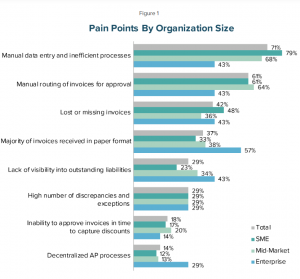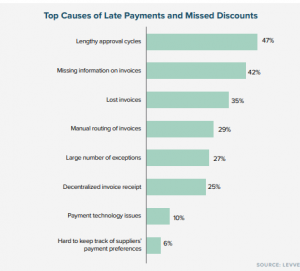A strong, motivated AP team is an invaluable asset to any company. Successful leaders keep morale amongst the AP department high. However, this isn’t achieved without investing in your AP team and remaining vigilant for signs that it is time to update AP processes.
Here’s the 5 telling signs your AP team is in crisis and what you can do to avert any further problems and create a united team.
1. High staff turnover and unplanned absences
Manual processing of invoices is cumbersome and without any noticeable strides to improve the process, frustration and demotivation can occur in your most valuable employees. Technology is evolving to enhance working conditions and if your employees begin to feel that they’re being left behind, it could factor into them deciding to seek employment elsewhere that use modern methods.
Are you seeing problems arise with productivity with your team, are they dipping or remaining stagnant? The repetitive nature of manual tasks such as data entry or three-way matching can negatively impact AP’s production. A Levvel report documented that AP teams spend a significant amount of resources on entering, verifying, correcting, and updating information paper invoices and supplier invoices. This often interferes with productivity and performance. Workers are also inclined to complete the same volume of work as their peers as there is no incentive for high performance.
If the AP door is continually revolving with new faces around the office every week, you might want to think about hitting the crisis button. In a manual environment, new staff members will learn through tribal knowledge, if there is no process in place. This is a big red flag, as it slows down everyone’s productivity and it wreaks havoc with daily tasks to make time for training.

2. Increased use of temporary resources
As your company expands, the volume of invoices will do so too. In addition to busy periods such as year-end or other peak periods, the pressure intensifies on your team. Temporary staff are usually brought on to tackle the extra demand for the AP department.
If you’re doing this, you should be aware that it is a prominent red flag. It highlights the insufficient processes in place that are straining your team and your resources. Using effective processes will allow your business to grow without a major requirement for temporary staff. We recently wrote more about hiring temporary staff at Month-end and the consequences, read it here.
3. More Mistakes
Data entry takes up a significant amount of time for the AP team when they are relying on a manual process. It’s likely that human error will occur. Not only will it be difficult to detect, but it costs a huge amount of resources to try and amend the mistake. The employee’s day and your finances are placed on hold until the error is corrected.
The AP team should have clear direction about their workload and the standard from management. If this element is missing, employees tend to lean on their own interpretations of timelines, tasks, and expectations. Management is then reliant on employees’ assessment, which varies from person to person and can, in some cases, lead to inaccuracies. Management should have processes that allow monitoring and clear visibility to employee’s day to day activities.
4. Missing Deadlines
Lengthy approval cycles are the top cause of late payments and missed discounts according to a Levvel study. Manual routing of invoices takes time and if your staff are beginning to fall behind and miss deadlines, it’s a sign that they’re crying out for help. Additionally, if the required information isn’t on the invoices, it leads to the process being delayed and chasing departments or suppliers. The manual process you have in place mightn’t be doing its job in aiding the department.

5. Lack of ownership
Insufficient emphasis on who owns what work means that trying to get tasks completed on time can get complicated. It becomes a bigger issue when employees are absent. It may be unclear to exactly what they were working on before their illness, meaning that their work won’t be delegated out and subsequently won’t be finished within the deadline.
This lack of ownership generally manifests as a result of the culture of the organization and the lack of appropriate processes in place to ensure that all work gets completed on time.
How to fix the problems in your AP team
If you can identify that your team is in crisis, don’t panic. Reach for solutions such as review, re-design, and automation.
Review and Re-design
By reviewing processes, you can identify inefficiencies that may have previously gone unnoticed. By re-designing processes you can address the inefficiencies, you can ensure a much more standardized, secure, and controlled environment. Listen to your staff and seek to amend the issues they raise with your current process.
Automation
An automated process will allow you to deplete or get rid of the reliance on temporary staff. Automation means that the repetitive, time-consuming tasks your employees do are replaced by software. In turn, they’re able to manage their workload. It also gives management full visibility and control over the end to end AP process, so they can assign, monitor, and report on employee’s work. This structure implements ownership, productivity, and motivation by giving employees a standard to work towards. According to a recent report, organizations that have a streamlined invoice process in AP are five-times more efficient than other companies who don’t, with a difference of $2.52 and $14.38 per invoice.
Before making the switch to automation, there’s a number of checklist items you need to go through. Luckily for you, we’ve already written a blog on how to plan for a switch.
Conclusion
If your AP staff are in crisis mode, don’t ignore it. If you’ve noticed the cracks have already begun to show, make sure you address the issues sooner, rather than later. Listen to what your AP staff are telling you about their pains and give them the gift of automation.


